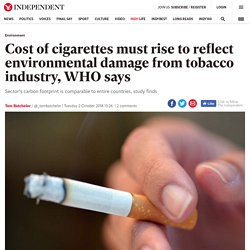

The people fighting pollution with plastic-free periods. Menstrual cups make a difference for refugee women. Tobacco control, a ‘major component’ of environmental protection efforts – UN health official. The World Health Organization Framework Convention on Tobacco Control (WHO FCTC), which is celebrating the 15th anniversary of it being adopted this year – is a global health treaty that advocates for the control of tobacco production, sale and use, as a way of reducing tobacco-related illnesses, deaths, environmental degradation and poverty across the world.

“People often immediately think of the health impact that tobacco has, but there is not enough awareness of how tremendously destructive it is for the environment too, on land, under water and in the air,” said Dr. Vera Luiza da Costa e Silva, the Head of the WHO FCTC Secretariat. “Studies indicate that tobacco growing could be up to 10 times more aggressive than all other deforestation factors,” Dr. da Costa e Silva noted. Governments need to understand that tobacco control is a major component of any effective and holistic environmental protection effort - Dr. Vera Luiza da Costa e Silva, WHO FCTC Secretariat chief.
Cost of cigarettes must rise to reflect environmental damage from tobacco industry, WHO says. The price of a packet of cigarettes should rise to reflect the wide-ranging environmental damage caused by the tobacco industry, from deforestation to water pollution, a major report has recommended.

Backed by the World Health Organisation (WHO), the study found the industry’s carbon footprint was comparable to entire countries. Tobacco farms accounted for the loss of around 5 per cent of forests in parts of Asia and Africa, it stated. The UK was among the countries singled out for criticism along with several other western nations which were condemned for “literally burning poorer countries’ resources”. Cigarette production and consumption have seen dramatic growth in recent decades with around six trillion cigarettes manufactured annually for an estimated one billion smokers. Aside from Damaging Our Health, Smoking Also Harms the Environment. The tobacco industry’s carbon footprint is greater than that of entire countries, such as Israel or Peru.

Tobacco’s disastrous effects on human health have been clear for decades, despite industry giants trying to hide the evidence linking cigarette smoke and disease for as long as possible. Despite Big Tobacco’s machinations, countless public awareness campaigns have exposed the drug’s role in causing lung cancer and numerous other serious conditions. Legislation around the world has slowly chipped away at the once-dominant addiction: Smoking prevalence has decreased by more than half in some developed countries since 1980 and continues to decline. This progress has substantially contributed to cancer prevention efforts. Melting Arctic Permafrost Could Release Tons of Toxic Mercury. Scientists have uncovered another hidden threat buried in the icy frozen north—massive natural reserves of mercury, a toxic heavy metal that in some forms can build up in fish and other animals and cause serious health problems in humans.

The Zombie Diseases of Climate Change. From the air, the coast of Greenland appears vast and tranquil. Hundreds of fjords, their surfaces a mirror of blue sky and cloud bottoms, divide the territory. Oh, Great: There's Lots of Mercury in the Thawing Permafrost – Futurism. Arctic Permafrost Stores More Mercury Than The Rest Of The World's Soils, The Oceans, & The Atmosphere Combined...Two Times Over. March 5th, 2018 by James Ayre.

Plagues from the Permafrost: Will Thawing Ice Bring Back the Curse of the Mummy’s Tomb? Nearly a century ago, Lord Carnavon, who attended the opening of King Tut’s Tomb, died shortly afterwards, in April 1923. At the time, the sensational media linked his death to supernatural causes activated by the curse of the mummy’s tomb. More recently, this tale was rationalized by suggesting that his death was due to ancient disease causing microbes, lurking in the tomb, rather than supernatural influences. Modern technology has been used to examine mummies to attempt to diagnose any infections that they had, which might have been the cause of death. Mummies and other reasonably well-preserved corpses have indeed yielded signs of infection.
Melting permafrost in the Arctic is unlocking diseases and warping the landscape. You can find evidence of a changing climate everywhere on Earth.

But nowhere are the changes more dramatic than in the Arctic. Our world’s northern polar region is warming twice as fast as the global average. And the consequences are easy to spot. On average, Arctic sea ice extent is shrinking every summer. The Greenland ice sheet is becoming unstable. But perhaps most disturbing are the changes occurring underground in the permafrost. Now it’s melting. A recent Arctic Council report says that 20 percent of the permafrost near the surface may melt by 2040. A 2010 study in Russia found 0.5°C to 2°C of permafrost warming in the past three decades, bringing some locations dangerously close to thawing and pushing the boundary of permafrost regions ever northward.
When it thaws, a Pandora’s box is unleashed. A week earlier, Holmes and his students had set up temperature sensors in the soil near their encampment. Here’s how. 1) Permafrost has been frozen for millennia.